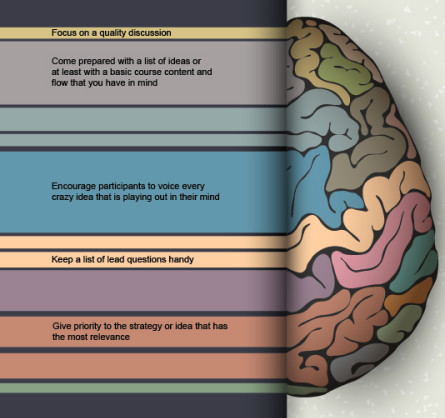
As Instructional Designers, you develop training, that is technically accurate, well-written, and visually pleasing. In addition, you must ensure that the training includes new and innovative instructional strategies to teach and engage learners. You need to avoid repeats especially in situations when you are developing a curriculum for a specific audience. Repeating strategies could make the learning experience monotonous. As a result, your learners may not engage with the learning course. So, from where can you get new ideas?
Consider Samantha, an Instructional Designer who is worried! She has to deliver a Design Document for an eLearning course. The stakeholders expect a course with out-of-the-box strategies, not a mere page-turner. The existing eLearning the client company depends upon has gaps and does not motivate learners to complete the entire curriculum. Samantha realizes that the time is crunched and resources are limited. She has just two days to present her design document. What now? Another meeting? Team discussion? Sleepless nights?
It is in situations such as these that teams resort to brainstorming because they can quickly pool in the best of ideas within a short span of time. A Brainstorming session is often the most forgotten or neglected of steps when it comes to analysis or design phases in a project’s lifecycle. It is easy to brainstorm a design because with multiple people on the team there are more ideas that fly in and you can certainly innovate on something new with each course that you develop. You can make a brainstorming session effective and successful by following some simple dos’ and don’ts.
Let’s take a look at some of the dos’ first:
- Focus on a quality discussion. When discussing ideas or course strategies, the team should keep their focus on the objective at hand so as not to digress from the topic. For example, if you are brainstorming strategies for a Web-based Training, ask the team to share some of the best interactions that they’ve seen or developed. Include your technical and multimedia team in discussions to assess the feasibility of whether the interaction can be created within your project scope and standards. Also, allocating a time limit is a good idea to ensure the brainstorming session is on track. Brainstorming is about moving fast and gathering as many ideas as possible within a limited time frame.
- Come prepared with a list of ideas or at least with a basic course content and flow that you have in mind. This helps nudge the discussion forward and people can contribute with different ideas on the treatment or presentation of content. If you have a skeletal design for the course, others can help you flesh it out better! You can always give priority to the ideas that have the most relevance.
- Encourage participants to voice every crazy idea that is playing out in their mind. Even though a majority of participants may not agree with an idea that appears crazy, encouraging people to voice their ideas can unleash interesting strategies. The key is to generate as many ideas as possible, isn’t it? Listen to each idea. You can strike off the ones you do not like later. You never know … sometimes you can create a bigger and better strategy when you innovate to combine one or more ideas that come to you.
- Keep a list of lead questions handy. During a discussion, it is a good idea to use a well-crafted lead question to boost the participants’ creativity. It reminds them of their individual thinking caps and can set the discussion rolling. Use unrelated word or images that can trigger ideas. Suppose the brainstorming revolves around an instructional strategy you want to approach for a course that you re designing, keeping in mind the content type, you can ask questions such, as “Which is the best strategy to present a new process to the learners?”, or, “We have to create an interactive learning course for our client to explain a new process to their new hires. What works best: A story-based approach, a branching scenario, or a simulation?” or, “How would you have improvised on the last course you worked on to make it more learner-centric and interactive?” “How would you turn a best practices course from a mere a page turner to a more interactive learning?” Sometimes, asking a simple question, such as, “Which is the worst course that you have worked on?” can also be effective. The trick is to first talk about the worst course they have contributed to developing and just when the discussion is at its peak, shift gears to ask, “Ok , so now what would you do to develop the worst course into one of the best?”
- Give priority to the strategy or idea that has the most relevance. It is but normal that good ideas fly in from all directions. But it makes sense to pick the most associated and relevant idea and prioritize to flesh it out further. Also, writing it out on a flip board or whiteboard helps participants visualize the strategy better. Using illustrations and diagrams certainly helps.
Now for some don’ts … which you must be careful about:
- Do not criticize. Criticism should be avoided to help conduct a healthy brainstorming discussion. If I am afraid of being criticized or mocked at, would I share this crazy idea or strategy that has been playing in my mind? Of course, no! So welcome crazy ideas because they sometimes make more sense than run-of-the-mill strategies.
- Do not be rigid. A good brainstorming session is an unconventional approach to finding the right strategy. Be flexible and allow ideas to be flipped upside down and deviate from the normal processes which you are used to.
- Do not let it out of your control. Through discussions and counter discussions, do not disrespect the person behind an idea you do not agree with. Listen without interrupting and allow everyone to speak. Grabbing attention will make you lose out on an awesome idea your colleague wants to share. Let everyone put their suggestions forth on the table.
- No idea is a bad idea so do not forget to document. It is a good practice to have a time limit and to conclude the session, pull together all the viable strategies that have been discussed. Back up all the data with the suggestions and ideas from participants recorded as is. It could be possible that the strategy that isn’t shortlisted today works for another course that you work on in future? Creating an idea bank is also good idea!
- Do not be judgmental. Accept a strategy or an idea without comments. Discuss them if you do not agree, and give conclusive reasons to support your discussion. Remember, there is a thin line between discussion and arguments. Stick to healthy dialogue.
Author: Deepdisha Doshi
Here is the link to her LinkedIn Profile.



